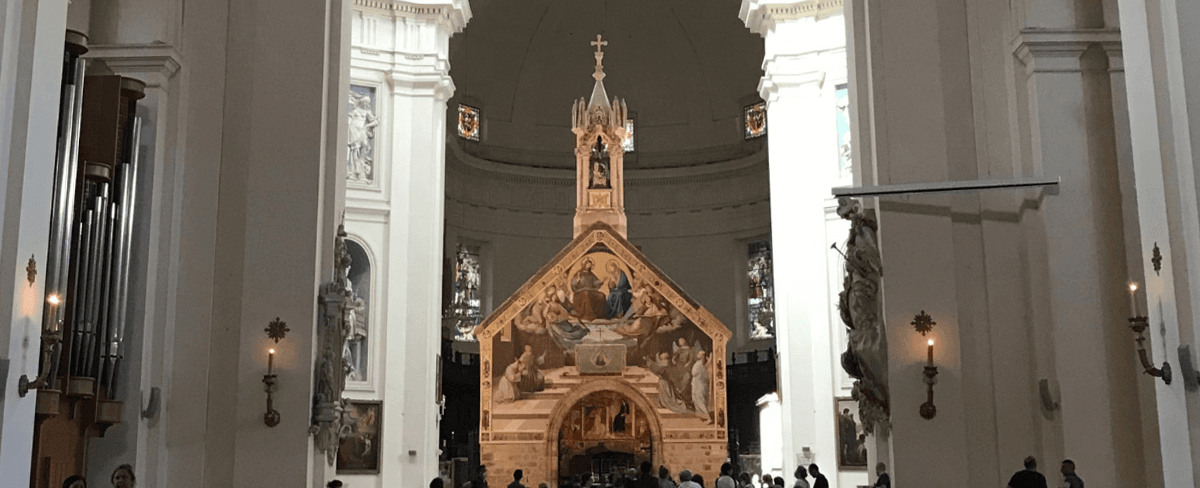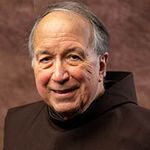Feast of the Dedication of the Chapel of St. Mary of the Angels in Assisi

On August 2, the Franciscan family celebrates the dedication of the chapel of St. Mary of the Angels in Assisi.
Early history
Located down in the valley about two and half miles below the city of Assisi, this small chapel, the beloved "Portiuncula" or "Little Portion," occupies a pivotal role in Franciscan history. Probably built originally in the 9th century by some hermits, by the 12th century the little-used chapel came into the possession of the Benedictine abbey on Mount Subasio. It was one of the churches in the Assisi area that Francis restored in the early years of his conversion (1207-08), and where he gathered his first companions.

In the interior of the chapel, the central scene on the wooden panel over the altar depicts the Annunciation, surrounded by the story of the granting of the Portiuncula Indulgence. In the top scene Francis kneels before Christ and Mary enthroned in heavenly glory. It was painted by Ilario of Viterbo in 1393.
Home base for Franciscans
When the brothers first received approval of their way of life from Innocent III in 1209, they settled briefly at a place called Rivo Torto, but soon returned to the Portiuncula about 1210. This became “home base” for the Lesser Brothers, the friars agreeing to pay a symbolic annual "‘rent" of fish to the abbot of Mount Subasio. Adjoining the humble chapel, the brothers built a collection of individual huts or “cells” made of wattle and daub. The Portiuncula is where Francis received Clare into his movement a few years later and where he returned to die in 1226. This shrine to Mary remains today the spiritual “motherhouse” of the Order of Friars Minor.
The “Pardon of Assisi”
Francis desired that everyone experience the overwhelming love and mercy of God in this place just as he had, and so, according to tradition, in 1216 he persuaded Pope Honorius III to grant a plenary indulgence to all persons who visit this chapel, prayerful and repentant, on the feast of its dedication. On August 2, thousands of pilgrims still converge here to receive the "Pardon of Assisi," as this indulgence is commonly called in Italy.
Today this plenary indulgence may be gained in any Franciscan church or chapel and in all parish churches throughout the world from noon on August 1 through midnight on August 2. The usual conditions for this indulgence apply: sacramental confession (up to a week prior or after), Mass with Holy Communion, recitation of the Apostles’ Creed and the Our Father, prayer for the intention of the Pope.

To shelter the vast throngs of pilgrims coming to Assisi, Pope Pius V ordered that a large basilica be built to enclose the small chapel of the Portiuncula. The Basilica of St. Mary of the Angels was constructed in the Mannerist style between 1569 and 1679 and rebuilt after a severe earthquake in 1832. The facade was restored in the 1920s.
A message of “pardon and reconciliation”
Saint John Paul II once said the message of the Portiuncula Indulgence is one of “pardon and reconciliation, that is, of grace, which divine goodness pours out on us if we are well disposed because God is truly rich in mercy.”
Let us pray with Francis
Hail, O Lady,
Holy Queen,
Mary, holy Mother of God,
Who are the Virgin made Church,
chosen by the most Holy Father in heaven
whom he consecrated with His most holy beloved Son
and with the Holy Spirit the Paraclete,
in whom there was and is
all fullness of grace and every good.Hail His Palace!
Hail His Tabernacle!
Hail His Dwelling!
Hail His Robe!
Hail His Servant!
Hail His Mother!And hail all You holy virtues
which are poured into the hearts of the faithful
through the grace and enlightenment of the Holy Spirit,
that from being unbelievers,
You may make them faithful to God.
Main image: The Portiuncula stands inside the Basilica of St. Mary of the Angels. The fresco on the exterior and the little spire were added to this simple chapel in the 19th century. (photo credit: Maria Hayes)
Dominic Monti, OFM
Professor of Franciscan Research in the Franciscan Institute of St. Bonaventure University
Dominic V. Monti, OFM, is a Franciscan Friar of Holy Name Province (USA) and currently professor of Franciscan Research in the Franciscan Institute of St. Bonaventure University. He devoted the greater part of his ministry to teaching the History of Christianity, in particular the history of the Franciscan movement. He has contributed two volumes to the Works of St. Bonaventure series and is author of Francis & His Brothers, a popular history of the Friars Minor.

